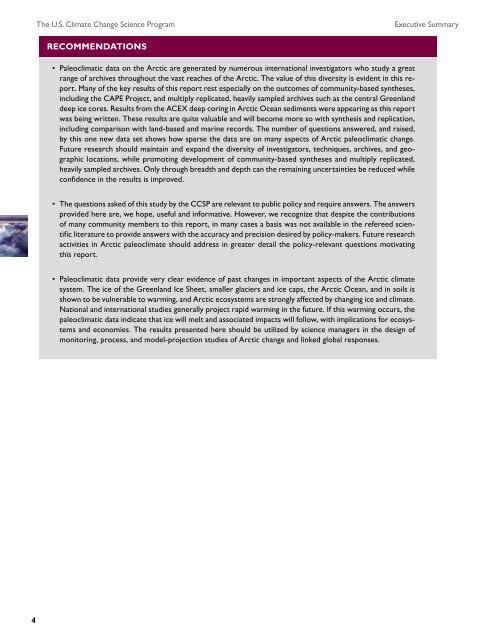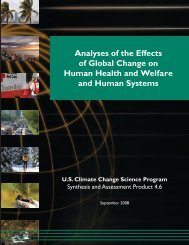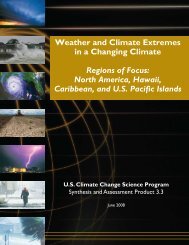Past Climate Variability and Change in the Arctic and at High Latitudes
Past Climate Variability and Change in the Arctic and at High Latitudes
Past Climate Variability and Change in the Arctic and at High Latitudes
Create successful ePaper yourself
Turn your PDF publications into a flip-book with our unique Google optimized e-Paper software.
4<br />
The U.S. <strong>Clim<strong>at</strong>e</strong> <strong>Change</strong> Science Program Executive Summary<br />
RECOMMENDATIONS<br />
• Paleoclim<strong>at</strong>ic d<strong>at</strong>a on <strong>the</strong> <strong>Arctic</strong> are gener<strong>at</strong>ed by numerous <strong>in</strong>tern<strong>at</strong>ional <strong>in</strong>vestig<strong>at</strong>ors who study a gre<strong>at</strong><br />
range of archives throughout <strong>the</strong> vast reaches of <strong>the</strong> <strong>Arctic</strong>. The value of this diversity is evident <strong>in</strong> this report.<br />
Many of <strong>the</strong> key results of this report rest especially on <strong>the</strong> outcomes of community-based syn<strong>the</strong>ses,<br />
<strong>in</strong>clud<strong>in</strong>g <strong>the</strong> CAPE Project, <strong>and</strong> multiply replic<strong>at</strong>ed, heavily sampled archives such as <strong>the</strong> central Greenl<strong>and</strong><br />
deep ice cores. Results from <strong>the</strong> ACEX deep cor<strong>in</strong>g <strong>in</strong> <strong>Arctic</strong> Ocean sediments were appear<strong>in</strong>g as this report<br />
was be<strong>in</strong>g written. These results are quite valuable <strong>and</strong> will become more so with syn<strong>the</strong>sis <strong>and</strong> replic<strong>at</strong>ion,<br />
<strong>in</strong>clud<strong>in</strong>g comparison with l<strong>and</strong>-based <strong>and</strong> mar<strong>in</strong>e records. The number of questions answered, <strong>and</strong> raised,<br />
by this one new d<strong>at</strong>a set shows how sparse <strong>the</strong> d<strong>at</strong>a are on many aspects of <strong>Arctic</strong> paleoclim<strong>at</strong>ic change.<br />
Future research should ma<strong>in</strong>ta<strong>in</strong> <strong>and</strong> exp<strong>and</strong> <strong>the</strong> diversity of <strong>in</strong>vestig<strong>at</strong>ors, techniques, archives, <strong>and</strong> geographic<br />
loc<strong>at</strong>ions, while promot<strong>in</strong>g development of community-based syn<strong>the</strong>ses <strong>and</strong> multiply replic<strong>at</strong>ed,<br />
heavily sampled archives. Only through breadth <strong>and</strong> depth can <strong>the</strong> rema<strong>in</strong><strong>in</strong>g uncerta<strong>in</strong>ties be reduced while<br />
confidence <strong>in</strong> <strong>the</strong> results is improved.<br />
• The questions asked of this study by <strong>the</strong> CCSP are relevant to public policy <strong>and</strong> require answers. The answers<br />
provided here are, we hope, useful <strong>and</strong> <strong>in</strong>form<strong>at</strong>ive. However, we recognize th<strong>at</strong> despite <strong>the</strong> contributions<br />
of many community members to this report, <strong>in</strong> many cases a basis was not available <strong>in</strong> <strong>the</strong> refereed scientific<br />
liter<strong>at</strong>ure to provide answers with <strong>the</strong> accuracy <strong>and</strong> precision desired by policy-makers. Future research<br />
activities <strong>in</strong> <strong>Arctic</strong> paleoclim<strong>at</strong>e should address <strong>in</strong> gre<strong>at</strong>er detail <strong>the</strong> policy-relevant questions motiv<strong>at</strong><strong>in</strong>g<br />
this report.<br />
• Paleoclim<strong>at</strong>ic d<strong>at</strong>a provide very clear evidence of past changes <strong>in</strong> important aspects of <strong>the</strong> <strong>Arctic</strong> clim<strong>at</strong>e<br />
system. The ice of <strong>the</strong> Greenl<strong>and</strong> Ice Sheet, smaller glaciers <strong>and</strong> ice caps, <strong>the</strong> <strong>Arctic</strong> Ocean, <strong>and</strong> <strong>in</strong> soils is<br />
shown to be vulnerable to warm<strong>in</strong>g, <strong>and</strong> <strong>Arctic</strong> ecosystems are strongly affected by chang<strong>in</strong>g ice <strong>and</strong> clim<strong>at</strong>e.<br />
N<strong>at</strong>ional <strong>and</strong> <strong>in</strong>tern<strong>at</strong>ional studies generally project rapid warm<strong>in</strong>g <strong>in</strong> <strong>the</strong> future. If this warm<strong>in</strong>g occurs, <strong>the</strong><br />
paleoclim<strong>at</strong>ic d<strong>at</strong>a <strong>in</strong>dic<strong>at</strong>e th<strong>at</strong> ice will melt <strong>and</strong> associ<strong>at</strong>ed impacts will follow, with implic<strong>at</strong>ions for ecosystems<br />
<strong>and</strong> economies. The results presented here should be utilized by science managers <strong>in</strong> <strong>the</strong> design of<br />
monitor<strong>in</strong>g, process, <strong>and</strong> model-projection studies of <strong>Arctic</strong> change <strong>and</strong> l<strong>in</strong>ked global responses.




